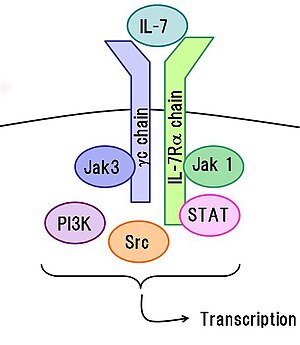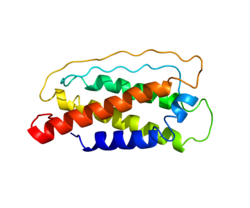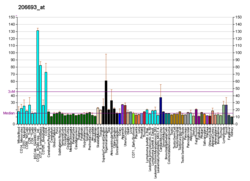Interleukin 7
Interleukin 7 (IL-7) is a protein[5] that in humans is encoded by the IL7 gene.[6][7][8]
IL-7 is a hematopoietic growth factor secreted by stromal cells in the bone marrow and thymus. It is also produced by keratinocytes,[9] dendritic cells,[10] hepatocytes,[11] neurons, and epithelial cells[12] but is not produced by normal lymphocytes.[13]
Structure
The three-dimensional structure of IL-7 in complex with the ectodomain of IL7R has been determined using X-ray diffraction.[14]
Function
Lymphocyte maturation
IL-7 stimulates the differentiation of multipotent (pluripotent) hematopoietic stem cells into lymphoid progenitor cells (as opposed to myeloid progenitor cells where differentiation is stimulated by IL-3).[citation needed] It also stimulates proliferation of all cells in the lymphoid lineage (B cells, T cells and NK cells).[citation needed] It is important for proliferation during certain stages of B-cell maturation, T and NK cell survival, development and homeostasis.[citation needed]
IL-7 is a cytokine important for B and T cell development. This cytokine and the hepatocyte growth factor (HGF) form a heterodimer that functions as a pre-pro-B cell growth-stimulating factor. This cytokine is found to be a cofactor for V(D)J rearrangement of the T cell receptor beta (TCRß) during early T cell development.[15] This cytokine can be produced locally by intestinal epithelial and epithelial goblet cells, and may serve as a regulatory factor for intestinal mucosal lymphocytes.[citation needed] Knockout studies in mice suggested that this cytokine plays an essential role in lymphoid cell survival.[16]
IL-7 signaling

IL-7 binds to the IL-7 receptor, a heterodimer consisting of Interleukin-7 receptor alpha and common gamma chain receptor.[17] Binding results in a cascade of signals important for T-cell development within the thymus and survival within the periphery. Knockout mice which genetically lack IL-7 receptor exhibit thymic atrophy, arrest of T-cell development at the double positive stage, and severe lymphopenia. Administration of IL-7 to mice results in an increase in recent thymic emigrants, increases in B and T cells, and increased recovery of T cells after cyclophosphamide administration or after bone marrow transplantation.
Disease
Cancer
IL-7 promotes hematological malignancies (acute lymphoblastic leukemia, T cell lymphoma).[18]
Viral Infections
Elevated levels of IL-7 have also been detected in the plasma of HIV-infected patients.[19]
Transplantation
Clinical application
IL-7 as an immunotherapy agent has been examined in many pre-clinical animal studies and more recently in human clinical trials for various malignancies and during HIV infection.[13][20]
Cancer
Recombinant IL-7 has been safely administered to patients in several phase I and II clinical trials. A human study of IL-7 in patients with cancer demonstrated that administration of this cytokine can transiently disrupt the homeostasis of both CD8+ and CD4+ T cells with a commensurate decrease in the percentage of CD4+CD25+Foxp3+ T regulatory cells.[21] No objective cancer regression was observed, however a dose limiting toxicity (DLT) was not reached in this study due to the development of neutralizing antibodies against the recombinant cytokine.
HIV infection
Associated with antiretroviral therapy, IL-7 administration decreased local and systemic inflammations in patients that had incomplete T-cell reconstitution. These results suggest that IL-7 therapy can possibly improve the quality of life of those patients.[22]
Transplantation
IL-7 could also be beneficial in improving immune recovery after allogenic stem cell transplant.[23]
References
- ^ a b c GRCh38: Ensembl release 89: ENSG00000104432 – Ensembl, May 2017
- ^ a b c GRCm38: Ensembl release 89: ENSMUSG00000040329 – Ensembl, May 2017
- ^ "Human PubMed Reference:". National Center for Biotechnology Information, U.S. National Library of Medicine.
- ^ "Mouse PubMed Reference:". National Center for Biotechnology Information, U.S. National Library of Medicine.
- ^ Namen AE, Lupton S, Hjerrild K, Wignall J, Mochizuki DY, Schmierer A, Mosley B, March CJ, Urdal D, Gillis S (June 1988). "Stimulation of B-cell progenitors by cloned murine interleukin-7". Nature. 333 (6173): 571–3. Bibcode:1988Natur.333..571N. doi:10.1038/333571a0. PMID 3259677.
- ^ Goodwin RG, Lupton S, Schmierer A, Hjerrild KJ, Jerzy R, Clevenger W, Gillis S, Cosman D, Namen AE (January 1989). "Human interleukin 7: molecular cloning and growth factor activity on human and murine B-lineage cells". Proc. Natl. Acad. Sci. U.S.A. 86 (1): 302–6. Bibcode:1989PNAS...86..302G. doi:10.1073/pnas.86.1.302. PMC 286452. PMID 2643102.
- ^ Sutherland GR, Baker E, Fernandez KE, Callen DF, Goodwin RG, Lupton S, Namen AE, Shannon MF, Vadas MA (July 1989). "The gene for human interleukin 7 (IL7) is at 8q12-13". Hum. Genet. 82 (4): 371–2. doi:10.1007/BF00274000. PMID 2786840.
- ^ Lupton SD, Gimpel S, Jerzy R, et al. (1990). "Characterization of the human and murine IL-7 genes". J. Immunol. 144 (9): 3592–601. PMID 2329282.
- ^ Heufler C, Topar G, Grasseger A, et al. (September 1993). "Interleukin 7 is produced by murine and human keratinocytes". J. Exp. Med. 178 (3): 1109–14. doi:10.1084/jem.178.3.1109. PMC 2191157. PMID 8350050.
- ^ Kröncke R, Loppnow H, Flad HD, Gerdes J (October 1996). "Human follicular dendritic cells and vascular cells produce interleukin-7: a potential role for interleukin-7 in the germinal center reaction". Eur. J. Immunol. 26 (10): 2541–4. doi:10.1002/eji.1830261040. PMID 8898972.
- ^ Sawa Y, Arima Y, Ogura H, et al. (March 2009). "Hepatic interleukin-7 expression regulates T cell responses". Immunity. 30 (3): 447–57. doi:10.1016/j.immuni.2009.01.007. PMID 19285437.
- ^ Watanabe M, Ueno Y, Yajima T, et al. (1995). "Interleukin 7 is produced by human intestinal epithelial cells and regulates the proliferation of intestinal mucosal lymphocytes". J. Clin. Invest. 95 (6): 2945–53. doi:10.1172/JCI118002. PMC 295983. PMID 7769137.
- ^ a b Fry TJ, Mackall CL (June 2002). "Interleukin-7: from bench to clinic". Blood. 99 (11): 3892–904. doi:10.1182/blood.V99.11.3892. PMID 12010786.
- ^ McElroy CA, Dohm JA, Walsh ST (January 2009). "Structural and biophysical studies of the human IL-7/IL-7Ralpha complex". Structure. 17 (1): 54–65. doi:10.1016/j.str.2008.10.019. PMC 2654238. PMID 19141282.
- ^ Muegge K, Vila MP, Durum SK (July 1993). "Interleukin-7: a cofactor for V(D)J rearrangement of the T cell receptor beta gene". Science. 261 (5117): 93–5. Bibcode:1993Sci...261...93M. doi:10.1126/science.7686307. PMID 7686307.
- ^ "Entrez Gene: IL7 interleukin 7".
- ^ Noguchi M, Nakamura Y, Russell SM, et al. (1994). "Interleukin-2 receptor gamma chain: a functional component of the interleukin-7 receptor". Science. 262 (5141): 1877–80. Bibcode:1993Sci...262.1877N. doi:10.1126/science.8266077. PMID 8266077.
- ^ Or R, Abdul-Hai A, Ben-Yehuda A (December 1998). "Reviewing the potential utility of interleukin-7 as a promoter of thymopoiesis and immune recovery". Cytokines Cell. Mol. Ther. 4 (4): 287–94. PMID 10068062.
- ^ Napolitano LA, Grant RM, Deeks SG, et al. (January 2001). "Increased production of IL-7 accompanies HIV-1-mediated T-cell depletion: implications for T-cell homeostasis". Nat. Med. 7 (1): 73–9. doi:10.1038/83381. PMID 11135619.
- ^ Fry TJ, Mackall CL (2003). "Interleukin-7 and immunorestoration in HIV: beyond the thymus". J. Hematother. Stem Cell Res. 11 (5): 803–7. doi:10.1089/152581602760404603. PMID 12427286.
- ^ Rosenberg SA, Sportès C, Ahmadzadeh M, Fry TJ, Ngo LT, Schwarz SL, Stetler-Stevenson M, Morton KE, Mavroukakis SA, Morre M, Buffet R, Mackall CL, Gress RE (2006). "IL-7 administration to humans leads to expansion of CD8+ and CD4+ cells but a relative decrease of CD4+ T-regulatory cells". J. Immunother. 29 (3): 313–9. doi:10.1097/01.cji.0000210386.55951.c2. PMC 1473976. PMID 16699374.
- ^ Sereti I, Estes JD, Thompson WL, Morcock DR, Fischl MA, et al. (2014). "Decreases in Colonic and Systemic Inflammation in Chronic HIV Infection after IL-7 Administration". PLoS Pathogens. 10 (1): e1003890. doi:10.1371/journal.ppat.1003890. PMC 3907377. PMID 24497828.
{{cite journal}}: CS1 maint: unflagged free DOI (link) - ^ Snyder KM, Mackall CL, Fry TJ (July 2006). "IL-7 in allogeneic transplant: clinical promise and potential pitfalls". Leuk. Lymphoma. 47 (7): 1222–8. doi:10.1080/10428190600555876. PMID 16923550.
Further reading
- Möller P, Böhm M, Czarnetszki BM, Schadendorf D (1997). "Interleukin-7. Biology and implications for dermatology". Exp. Dermatol. 5 (3): 129–37. doi:10.1111/j.1600-0625.1996.tb00107.x. PMID 8840152.
- Appasamy PM (1999). "Biological and clinical implications of interleukin-7 and lymphopoiesis". Cytokines Cell. Mol. Ther. 5 (1): 25–39. PMID 10390077.
- Al-Rawi MA, Mansel RE, Jiang WG (2004). "Interleukin-7 (IL-7) and IL-7 receptor (IL-7R) signalling complex in human solid tumours". Histol. Histopathol. 18 (3): 911–23. PMID 12792903.
- Aspinall R, Henson S, Pido-Lopez J, Ngom PT (2004). "Interleukin-7: an interleukin for rejuvenating the immune system". Ann. N. Y. Acad. Sci. 1019: 116–22. Bibcode:2004NYASA1019..116A. doi:10.1196/annals.1297.021. PMID 15247003.
- Sica D, Rayman P, Stanley J, et al. (1993). "Interleukin 7 enhances the proliferation and effector function of tumor-infiltrating lymphocytes from renal-cell carcinoma". Int. J. Cancer. 53 (6): 941–7. doi:10.1002/ijc.2910530613. PMID 8473051.
- Kim JH, Loveland JE, Sitz KV, et al. (1997). "Expansion of restricted cellular immune responses to HIV-1 envelope by vaccination: IL-7 and IL-12 differentially augment cellular proliferative responses to HIV-1". Clin. Exp. Immunol. 108 (2): 243–50. doi:10.1046/j.1365-2249.1997.d01-1006.x. PMC 1904649. PMID 9158092.






